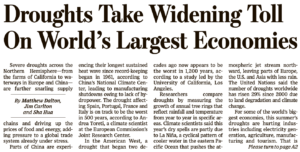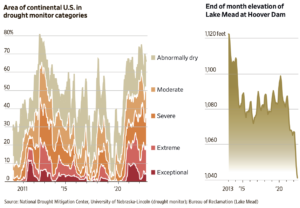Congress has quickly engaged in putting together potential aid packages for farmers that would more than double the Trump administration's $12 billion under the Farmer Bridge Assistance (FBA) Program.
Drought Negatively Impacting China, the U.S. and Europe, as Ukrainian Black Sea Exports Continue
Matthew Dalton, Jim Carlton and Sha Hua reported on the front page of today’s Wall Street Journal that, “Severe droughts across the Northern Hemisphere—stretching from the farms of California to waterways in Europe and China—are further snarling supply chains and driving up the prices of food and energy, adding pressure to a global trade system already under stress.

“Parts of China are experiencing their longest sustained heat wave since record-keeping began in 1961, according to China’s National Climate Center, leading to manufacturing shutdowns owing to lack of hydropower. The drought affecting Spain, Portugal, France and Italy is on track to be the worst in 500 years, according to Andrea Toreti, a climate scientist at the European Commission’s Joint Research Center.
“In the American West, a drought that began two decades ago now appears to be the worst in 1,200 years, according to a study led by the University of California, Los Angeles.”

Today’s Journal article pointed out that, “For some of the world’s biggest economies, this summer’s droughts are hurting industries including electricity generation, agriculture, manufacturing and tourism. That is compounding existing strains such as supply-chain disruptions stemming from the Covid-19 pandemic and pressure on energy and food prices from the war in Ukraine.
“In the U.S., agricultural forecasters expect farmers to lose more than 40% of the cotton crop, while in Europe the Spanish olive-oil harvest is expected to fall by as much as a third amid hot and dry conditions.”
More narrowly with respect to China, Wall Street Journal writers Sha Hua and Yang Jie reported last week that, “Some analysts worry that the drought and heat in China will damage the output of crops such as rice and corn for the fall harvest season in the country’s central regions and along the Yangtze River basin. The corn crop is in a key stage called tasseling, where bad heat or water conditions could hurt yields, said Darin Friedrichs, co-founder of Sitonia Consulting, a Shanghai-based agricultural research firm.
“The five provinces and one municipality affected by drought produced around a quarter of China’s total grain output in 2021, according to the National Bureau of Statistics.
“The impact of the drought and heat wave could lead Beijing to import more corn from Brazil or the U.S., Mr. Friedrichs said.”
On Saturday, Associated Press writer Mark Schiefelbein reported that, “Drought conditions across a swath of China from the densely populated east across central farming provinces into eastern Tibet have ‘significantly increased,’ the national weather agency said Saturday.”
And yesterday, in a separate AP article, Mr. Schiefelbein reported that, “China says it will try to protect its grain harvest from record-setting drought by using chemicals to generate rain, while factories in the southwest waited Sunday to see whether they would be shut down for another week due to shortages of water to generate hydropower.”
The article noted that, “The coming 10 days are a ‘key period of damage resistance’ for southern China’s rice crop, said Agriculture Minister Tang Renjian, according to the newspaper Global Times.
“Authorities will take emergency steps to ‘ensure the autumn grain harvest,’ which is 75% of China’s annual total, Tang said Friday, according to the report.”
Meanwhile, regarding dry weather in the U.S., Bloomberg writers Michael Hirtzer and Dominic Carey reported on Friday that, “The number of cattle sent to American feedlots — the last stop for fattening them up before slaughter — unexpectedly jumped in July with drought forcing ranchers to take their animals off pasture.

“The arid conditions have been shrinking herds for months, a pace that analysts anticipated was starting to slow. However, there were 1.8% more cattle placed into feedlots, compared to estimates in a Bloomberg survey for a 1.3% decline, a US Department of Agriculture report Friday showed.”

The Bloomberg article noted that, “‘Drought remains a major factor driving placements,’ said Altin Kalo, analyst at Steiner Consulting Group. ‘The report will work against cattle spreads on Monday’ with the data confirming near-term supplies are adequate.”
Elsewhere, on Saturday, Bloomberg writers Tarso Veloso Ribeiro, Tatiana Freitas, and Marvin G Perez reported that,
Extreme weather is wreaking havoc upon virtually all of the world’s largest cotton suppliers.
“In India, the top-producing country, heavy rains and pests have cut into cotton crops so much that the nation is importing supplies. A heat wave in China is raising concerns about the upcoming harvest there. In the US, the largest exporter of the commodity, a worsening drought is ravaging farms and is set to drag production to the lowest level in more than a decade. And now Brazil, the second-largest exporter, is battling extreme heat and drought that have already cut yields by nearly 30%.”
In other weather news regarding India, Bloomberg writers Pratik Parija and Vrishti Beniwal reported yesterday that, “Indian Prime Minister Narendra Modi boldly declared that his country was ready to ‘feed the world’ after Russia’s invasion of Ukraine. Less than four months later, the government needs to consider grain imports.
“Even before Modi made his pledge, a record-breaking heat wave that started in March was threatening Indian wheat output. That cut production and pushed up local prices, making everyday life more expensive for hundreds of millions of Indians that use the grain to make staple foods like naan and chappatis.”
“The looming shortage and rising prices now have authorities making preparations to facilitate overseas purchases,” the Bloomberg article said.
However, Reuters News reported yesterday that, “India has sufficient stocks of wheat and there is no plan to import the grain, the government clarified on Sunday after some media outlets reported New Delhi was planning to import wheat.”
Washington Post writer María Luisa Paúl highlighted dry weather impacts in parts of Europe in Sunday’s paper, reporting that: “Every year, farmers in France’s central region of Auvergne repeat the same process. During summer and fall, their cows graze in pastures, eating to their hearts’ content. It’s only during this time that farmers can produce salers, a highly regulated semihard cheese with the same buttery depth as a well-aged cheddar.
“That seasonal cycle remained uninterrupted for over 2,000 years until last week, when salers became the latest casualty of severe heat waves wreaking havoc across Europe, where human-caused climate change has intensified temperatures. France’s severe drought shut down the cheese production that had continued through two world wars, collapsed monarchies and the fall of the Roman Empire.”
And in developments regarding Ukraine Black Sea grain exports, Reuters News reported late last week that, “Two more ships carrying grain have left Ukraine’s Chornomorsk port, Turkey’s Defence Ministry said on Saturday, bringing the total number of vessels to leave Ukraine’s Black Sea ports under a U.N.-brokered grain export deal to 27.”
The first 10 ships from Ukraine carrying agricultural goods have now safely reached their final destinations.
— Ursula von der Leyen (@vonderleyen) August 19, 2022
This is a good start. Many more must follow.
Sea routes have to remain open so that Ukrainian food exports can arrive where they are needed. pic.twitter.com/ovxhCVMsbB
And yesterday Reuters reported that, “Four more ships carrying foodstuffs have left Ukraine’s ports, Turkey’s Defence Ministry said on Sunday, bringing the total number of vessels to leave Ukraine’s Black Sea ports under a U.N.-brokered grain export deal to 31.”





